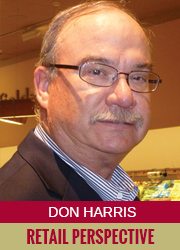Many Monday-morning discussions revolve around  new and innovative ways for using technology to advance retail sales. Management places a lot of emphasis on the capability of technology to make up for the need of additional personnel and/or expertise. In these conversations, management typically asks produce personnel why they don’t utilize more technology within their department. Why it is so difficult to get other systems in place, or to work with other departments. This discussion can be one of the most exasperating conversations for a produce employee. As management looks on in disbelief, produce personnel try to explain the intricacies of its operation. Obviously, “they just don’t get it”!
new and innovative ways for using technology to advance retail sales. Management places a lot of emphasis on the capability of technology to make up for the need of additional personnel and/or expertise. In these conversations, management typically asks produce personnel why they don’t utilize more technology within their department. Why it is so difficult to get other systems in place, or to work with other departments. This discussion can be one of the most exasperating conversations for a produce employee. As management looks on in disbelief, produce personnel try to explain the intricacies of its operation. Obviously, “they just don’t get it”!
Historically, produce has never been an area that embraced technology as readily as many other areas in the store. This was thought to be a product of “old school” perceptions and traditional operations within the department. In actuality, this slow progression was due to the fact that produce does not neatly fit into confined spaces and follow static roles necessary to fit easily into technological solutions.
Management often finds the concept inconceivable that every excellent technological solution for other departments will not fit neatly into the produce operation. It is precisely this misunderstanding by management that creates wasted efforts and discontent among produce department employees as they try to fit a square peg into a round hole. While it is certain technology has its purposes and place within produce operations, it is not a silver bullet for the optimum operation of a department.
Typically, management roles its eyes every time produce indicates that it has unique needs and requires different types of rules for optimum operation. To understand what is needed to present produce well, requires a certain “feel” and the benefit of experience in working with various commodities to generate and perpetuate sales. To say produce is more of an “art” than operation has some truth as we have all seen operations that are beautiful and also generate increasing sales and improved perception in the eyes of the customer.
Management often finds the concept inconceivable that every excellent technological solution for other departments will not fit neatly into the produce operation.
The most valuable asset of capability any produce operation can have is the ability to create a perception of freshness and quality in the mind of the customer. Technology can certainly plan a department’s schematic based on the size of the department, but it has difficulty locating the products by natural color and appeal not just by sales numbers.
While a technological solution to schematics has a certain amount of autonomy and is simple to follow, it promotes mediocrity and sterility to the presentation by reducing the creativity and training of produce personnel. This is precisely why technology has its limitations when applied to the best possible produce operation.
There are many examples of each type of operation in the industry, we all recognize a tight, technology-driven schematic in a department when we walk in. Conversely, we all marvel at the beauty and functionality of a superior produce operation artfully and functionally presented to address the customers’ needs and desires.
These night-and-day presentations are proof that the best way to sell produce and engage the customer is to utilize its natural beauty and appeal. All that one needs to verify this theory is the amount of produce in a shopping cart and the amount of time spent shopping the department. If you need further verification, simply ask a customer why they shop the department. Their answer, most likely, will be one of glowing praise for how fresh, well presented, and appetizing it looks. Additional comments would include, “It makes me want to buy.”
Unfortunately for the industry, this type of thinking is out of favor, especially for the larger chains. Efficiency and labor control dominates management’s thinking. Technology provides them with the solutions to make that square peg fit in the round hole. Yet the numbers and success of those retailers that continue to adopt the artistic aspect of fresh produce and its presentation continue to outperform anything technology has been able to accomplish. Perhaps a return to this artistic type of thinking in produce operations would help to reverse the overall trend of rising retail prices and declining volume. We could all benefit from looking beyond technology to what the true solution should be.
Don Harris is a 41-year veteran of the produce industry, with most of that time spent in retail. He worked in every aspect of the industry, from “field-to-fork” in both the conventional and organic arenas. Harris is presently consulting and is director of produce for the Chicago-based food charity organization, Feeding America. Comments can be directed to editor@producebusiness.com.


